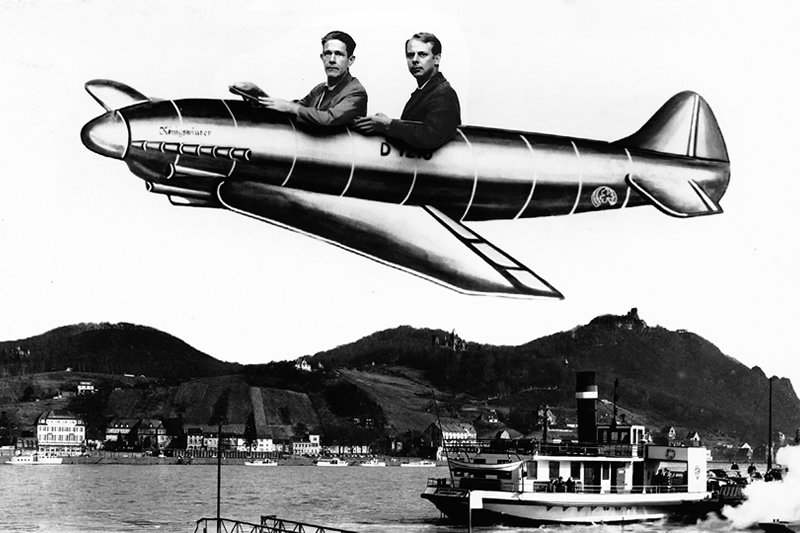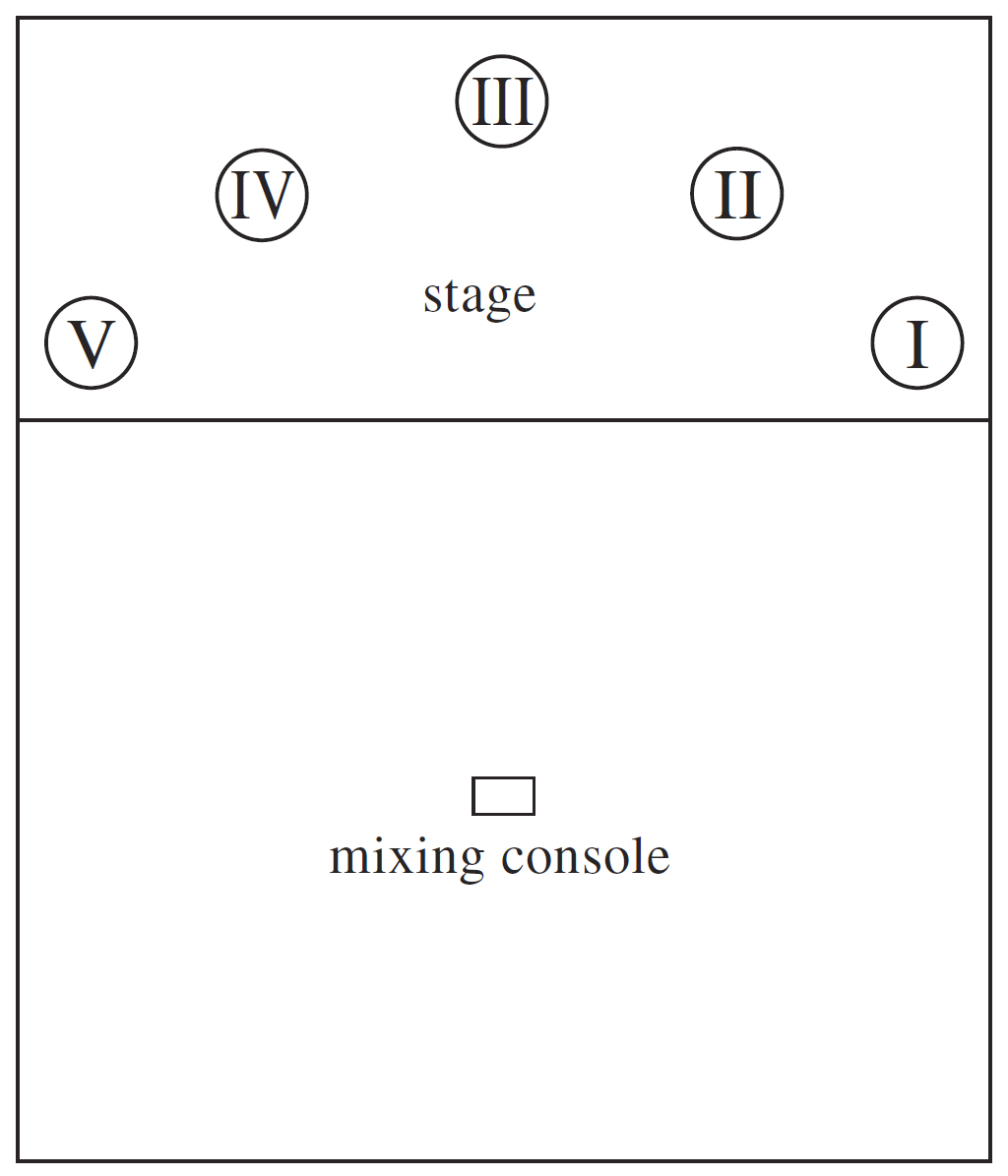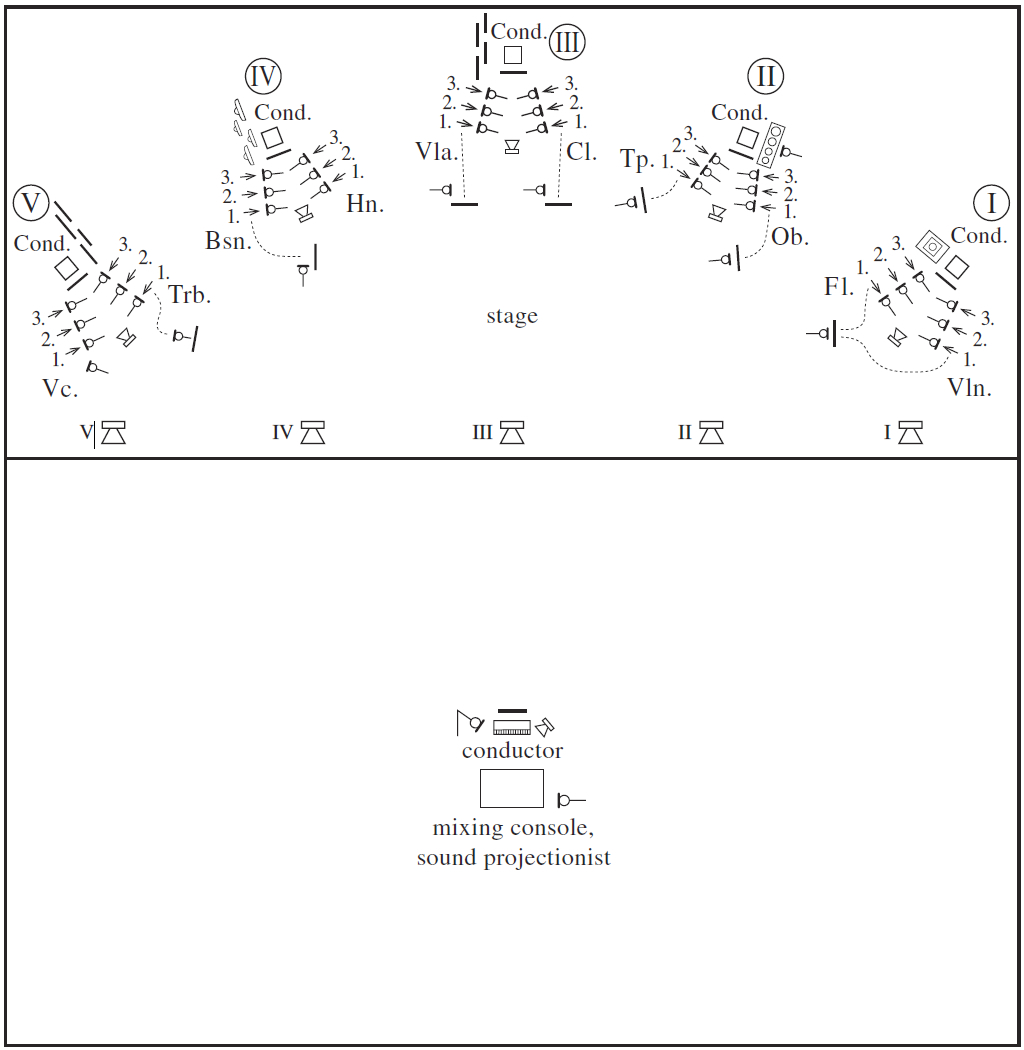
Instrumentation Works for Orchestra
Stockhausen Complete Edition on CD
Since 1991, a complete edition of all recordings in which Karlheinz Stockhausen has personally participated is being released on compact discs. Each CD in this series is identified by Stockhausen's signature followed by an encircled number. The numbers indicate the general historical order of the works.
Stockhausen realised the electronic music and participated in these recordings as conductor, performer, sound projectionist, and musical director. He personally mixed down the recordings, mastered them for CDs, wrote the texts and drew the covers.
- The compact discs may be obtained from the Stockhausen-Verlag: Kettenberg 15, 51515 Kuerten, Germany (www.stockhausenCDs.com).
Karlheinz Stockhausen
Instrumentation Works for Orchestra
HOCH-ZEITEN / HIGH-TIMES
Introduction
HOCH-ZEITEN for choir and orchestra is a combination of the 5th and 6th scenes of SUNDAY from LIGHT. It is notated in two scores: HOCH-ZEITEN for choir and HOCH-ZEITEN for orchestra. The present volume is the score of
HOCH-ZEITEN for orchestra.
A second volume contains the score of HOCH-ZEITEN for choir.
In HOCH-ZEITEN, the choir and orchestra simultaneously perform the work in 2 separate halls, quasi synchronously (with meeting points). Seven times during the performance, the orchestra is blended into the choir, and the choir into the orchestra, over loudspeakers.
In the intermission, either the audiences or the choir and orchestra change halls. (Duration: 2 x circa 35 minutes.)
If either the choir or orchestra is not available, it is possible to perform one of the two parts live and to play back a recording of the seven "blend-ins" of the other part over 5 x 2 or 5 loudspeakers.
Performance practice of the orchestra
| Winds and strings are divided into 5 groups: |
The 5 groups play on the stage: | ||
|---|---|---|---|
| Group I | 3 flutes, 3 violins, | right | Group I, |
| Group II | 3 oboes, 3 trumpets, | half-righ | Group II, |
| Group III | 3 clarinets in  , 3 violas, , 3 violas, |
middle | Group III, |
| Group IV | 3 horns in F, 3 bassoons, | half-left | Group IV, |
| Group V | 3 trombones, 3 violoncelli. | left | Group V. |
The 1st flute part should be played by a woman, if possible, due to the sections with voice plus instrument (pages 23–28), or a male flutist who has a tenor voice. The trumpets and trombones nearly always play with wawa mutes.
The two halves of each group sit facing each other with their profiles towards the audience. Microphones are used for amplification and transmission to the other hall (see the Orchestra set-up at the right).
Five assistant conductors conduct the groups (see pages XIV and XXI).
A conductor leads the entire work.

Solo instruments in the orchestra play five duets and two trios simultaneously with the rest of the orchestra:
1st trumpet – 1st clarinet (pages 5–10 of the score),
1st flute – 1st trombone (score pages 21–29),
1st viola – 1st violoncello (score pages 35–41),
1st trumpet (flugelhorn) – 1st trombone (score pages 49–55),
1st oboe – 1st bassoon (score pages 65–71),
1st clarinet – 1st violin – 1st violoncello (score pages 83–88),
1st flute – 1st viola – synthesizer (score pages 95–100).
Before beginning to play a duet or a trio, the players stand up, look towards each other and play as if conversing. Then they sit down again.
For each of these players, a second (high) music rack and microphone should stand ready (see the Orchestra set-up).
The synthesizer is played by the conductor.
The following percussion instruments stand next to the 5 groups:
| Group I: | 1 | antique cymbal ( "crotal" ) special cast for the low pitch, mounted on a resonator box. ( a total of 14 attacks ) |
sound  1 iron beater |
| Group II: | 4 | rin ( Japanese temple instruments: brass-coloured metal cups on cushions ) ( 15 attacks ) |
sound  1 wooden beater |
| Group III: | 4 | plate bells ( bronze ) ( 17 attacks ) |
sound  1 special felt beater with wooden core |
| Group IV: | 4 | Thai gongs ( nipple or bossed gongs ) ( 17 attacks ) |
sound notation  1 hard felt beater |
| Group V: | 4 | sound plates ( Duralumin ) ( 14 attacks ) |
sound  1 special felt beater with large wooden core |
These instruments are played by the five assistant conductors.
Choir, orchestra and percussion instruments are tuned to A = 442 Hz.
Instead of the percussion instruments, it is possible to play back – synchronous with the click-track tape – a 5-track tape of all the percussion sounds, dynamically balanced, over the five loudspeakers which are used for the amplification of the orchestra and choir blend-ins.
Orchestra set-up

 = 8 extra music stands for duets, trios and conductor.
= 8 extra music stands for duets, trios and conductor.
 = 41 microphones for orchestra, conductor, sound projectionist.
= 41 microphones for orchestra, conductor, sound projectionist.
 = 5 suspended loudspeakers (high) for the amplification of the five groups and
= 5 suspended loudspeakers (high) for the amplification of the five groups and
for the blend-ins of the choir from the other hall.
 = small loudspeakers for the comments of conductor and sound projectionist
= small loudspeakers for the comments of conductor and sound projectionist
during rehearsals.
The conductor and the five assistant conductors individually rehearse the
five groups, the duets and trios. Each assistant conductor is responsible for
rehearsing his group: he conducts all rehearsals and the concert. The assistant
conductors sit with their backs to the wall, facing the audience.
The conductor checks the sectional rehearsals, leads the tutti rehearsals,
plays the synthesizer (pages 95–100) and conducts the end (pages 119–122).
The five groups almost always play in 5 different tempi.
For the group rehearsals (and also during the performance), 5 synchronous click-tracks with pulses and spoken bar numbers (Stockhausen) are needed.
The pitches of the pulses for each click-track correspond to the pitches of
the respective group. (Click-tracks are also available for tuning pitch
A = 440 Hz.)
The page numbers of the score are spoken on track 6 of the tape
(Kathinka Pasveer); therefore, track 6 (page announcement) has to be
mixed to each click-track. The dynamic balance between the click-track
and page announcement can be set individually using a separate small mixer
having 6 inputs and 6 outputs (to the 5 assistant conductors and – if desired – to the conductor).
Several of the notated metronome tempi are approximations. Minor
time discrepancies at the synchronous places were compensated in the
click-tracks. The tracks are played back using an 8-track tape machine, and
each assistant conductor (wearing an inconspicuous small earphone) hears
the click-track of his group and track 6 with the page numbers.
Each orchestra member must receive his part and a compact disc with the click-track of his group in plenty of time. The musicians must prepare their parts in advance. None of the parts can be sight-read nor can they be learned during the normal rehearsal time, especially due to the bar and tempo changes, glissandi, noises, mute technique, etc.
There is a separate part for each orchestra group. The consecutive page
numbers of the score stand above each system.
The duets and trios, printed separately on larger pages, are included with the rental material.
After the five groups have rehearsed alone, they rehearse together. The conductor corrects and balances the groups. Then, the simultaneous rehearsals begin, with the orchestra in one hall and the choir in another hall.
In a performance, either the audiences or the orchestra and choir change halls for the second performance. Due to the different technical installations, it is better for the audiences to change halls.
Blend-ins
In the score, the beginhings and ends of the 7 blend-ins of the choir from the other hall are indicated. When the tutti rehearsals begin, a sound projectionist must balance the groups. At the places indicated in the score, he blends the choir in and out, and he makes envelope curves by ear. (See the positions of the 5 loudspeakers on page XIII.) The blend-ins should never cover the orchestra
In a performance, the orchestra must begin to play 18 seconds earlier than the choir. Accordingly, the click-tracks of the orchestra and choir are started I8 seconds apart. The two sound projectionists need to be able to communicate and to see each other (video) at all times.
To rehearse the sound projection – especially of the 7 blend-ins – it is possible to order two 8-track tapes from the publisher: one with the 5 choir
tracks and another one with the 5 orchestra tracks. For this, 2
8-track tape machines, 5 loudspeakers and a mixing console (10 → 5) are
needed. For comparison, an 8-track tape of Stockhausen's mix-down of the
orchestra with the 7 choir blend-ins may be used.
This information also applies to HOCH-ZEITEN for choir.
Suggestion for clothing
If possible, the colours of the clothing should correspond to the colours used in the first sketches:
| Group I | flutes – violins | sky-blue, |
| Group II | oboes – trumpets | bright green, |
| Group III | clarinets – violas | blue, |
| Group IV | horns – bassoons | orange, |
| Group V | trombones – violoncelli | bright violet. |
Also the assistant conductors wear these colours.
Staged performance
SUNDAY from LIGHT has 5 scenes, which should be performed on three days in succession:
| 1st day | 1 LICHTER – WASSER ( LIGHTS – WATERS) (no intermission) 2 ENGEL-PROZESSIONEN (ANGEL PROCESSIONS). |
|
| 2nd day | 3 LICHT-BILDER (LIGHT PICTURES) (intermission) 4 DÜFTE – ZEICHEN ( SCENTS – SIGNS) . |
|
| 3rd day | 5.1 HOCH-ZEITEN (HIGH-TIMES) for orchestra 5.1 HOCH-ZEITEN (HIGH-TIMES) for choir |
and reversed (with an intermission) |
SONNTAGS-ABSCHIED (SUNDAY FAREWELL) in the foyer. |
The HOCH-ZEITEN of the five groups in the orchestra and choir should be celebrated in five different cultures when staged. But also in concert performances, in the orchestra the duets and the couples in the two trios (clarinet and violin in the first trio, flute and viola in the second trio) are played, if possible, by a man and a woman – facing each other – from memory, with sympathetic gestures while mutually approaching each other.
In the choir, the five groups celebrate Indian, Chinese, Arabian, European and African HOCH-ZEITEN ( MARRIAGES ). Several dancer- mimes stand next to each choir group, and according to the language exchanges in the score, they visit other groups, bearing and exchanging gifts. All gestures and movements should be choreographically related to the scenes ANGEL PROCESSIONS and SCENTS — SIGNS. For rehearsals, recordings of the individual choir groups on compact discs, and the 8-track synchronous recording of all the choir groups may be used.
For a staging, if it is decided to perform the two parts successively in the same auditorium and to project recordings of the two times seven blend-ins over loudspeakers, then the orchestra part should be performed first, followed by the choir part after an intermission. Five-track or two-track recordings of the blend-ins may be ordered from the publisher.
Quasi concert world première
HOCH-ZEITEN was commissioned by Rafael Nebot (with Hans-Martin
Höpner as liason) for the Festival de Música de Canarias 2003. The world
première, performed by the choir and symphony orchestra of the West German Radio Cologne, took place on February 2nd 2003 in Las Palmas at the
Auditorio Alfredo Kraus, in the Sala Sinfonica and the Sala de Cámera simultaneously. The German premiere took place on February 14th 2003 in Cologne at the Philharmonic Hall and the large broadcasting auditorium (WDR).
Choir conductor: Rupert Huber and 5 choir members; orchestra conductor: Zsolt Nagy with 5 assistant conductors.
Synthesizer players: Antonio Pérez Abellán and Benjamin Kobler. (For
the first performances the scone still included several moments with two synthesizers in addition to the five orchestra groups. However, during the mixdown, Stockhausen deleted them because their sound was covered by that of the orchestra.)
Sound projection at the Philharmonic Hall: Karlheinz Stockhausen; at the large broadcasting auditorium (WDR): Bryan Wolf.
Management of the choir: Patricia Just; management of the orchestra:
Hans-Martin Höpner.